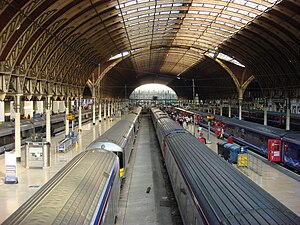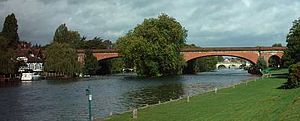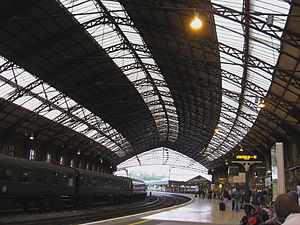Great Western Main Line
The Great Western Main Line is a main line railway in Great Britain, that runs westwards from London's Paddington station to Bristol and Swansea. The core Great Western Main Line runs from London Paddington to Temple Meads railway station in Bristol. A major branch of the Great Western diverges from the core line west of Swindon and terminates in Swansea. The term "Great Western" is also used to denote a wider group of associated routes.
Contents
History
The line was built by the Great Western Railway and engineered by Isambard Kingdom Brunel as a dual track line using a wider seven-foot broad gauge and was opened in stages between 1838 and 1840. The alignment was so level and straight it was nicknamed ‘Brunel’s Billiard Table’. It was supplemented with a third rail for dual gauge operation allowing standard-gauge trains to also operate on the route in stages between 1854 and 1875. Dual gauge was introduced as follows: London to Reading (1 October 1861), Reading to Didcot (22 December 1856), Didcot to Swindon (February 1872), Swindon to Thingley Junction, Chippenham (June 1874), Thingley Junction to Bathampton (16 March 1875), Bathampton to Bristol (June 1874), Bristol station area (29 May 1854). The broad gauge remained in use until 1892. Evidence of the original broad gauge can still be seen at many places where bridges are a wider than usual, or where tracks are ten feet apart instead of the usual six.
The original dual tracks were widened to four track in various places between 1877 and 1899. Paddington to Southall (1 October 1877), Southall to West Drayton (25 November 1878), West Drayton to Slough (1 June 1879), Slough to east side of Maidenhead Bridge (8 September 1884), Maidenhead Bridge to Reading (4 June 1893), Reading station (1899), Reading to Pangbourne (30 July 1893), Pangbourne to Cholsey and Moulsford (?), Cholsey and Moulsford to Didcot (27 December 1892), Various short sections between Didcot and Swindon, and at Bristol.
Further widening of the line took place between 1903 and 1910.[1]
The original route to Swansea, after the opening of Brunel's Chepstow Railway Bridge in 1852, left the Bristol-bound main line at Swindon, proceeding via Stroud, Gloucester and Chepstow before rejoining the line as we know it today at Severn Tunnel Junction. This gave rise to the nickname 'Great Way Round'.
In 1886, the opening of the Severn Tunnel brought the opportunity of a more direct route, and trains from Swindon to Newport and beyond were routed via Bristol and the Severn Tunnel. This route leaves the one we know today at Wootton Bassett near Swindon rejoining it close to Patchway station.
The route used today was established in 1903 with the building of what is often known as the Badminton Line.[2] This involved the construction of about 33 miles of new track including two tunnels at Alderton and Sodbury between Wootton Bassett and Patchway. Not only did this provide a more direct route, the gradient was easier for coal trains to negotiate, and it was perceived that the line would be a boost to what was, at the time of building, the expanding port of Fishguard. This was the GWR's connection with liner departures for the United States.
At the outbreak of World War I in 1914, the Great Western Railway was taken into government control, as were most major railways in Britain and were reorganised after the war into the "big four" companies, of which the Great Western Railway was one. The railways returned to direct government control during World War II before being nationalised to form British Railways in 1948.
More widening infrastructure work took place between 1931 and 1932, and the branch through Newport as far as Cardiff was quadrupled 1941.[3]
The line speed was upgraded in the 1970s to support the introduction of the InterCity 125 (HST).[4]
In 1977 the Parliamentary Select Committee on Nationalised Industries recommended considering electrification of more of Britain's rail network, and by 1979 BR presented a range of options that included electrifying the GW Main Line from Paddington to Swansea by 2000.[5] Under the 1979–90 Conservative governments that succeeded the 1976–79 Labour government the proposal was not implemented.
Heritage
The route of the GWML includes dozens of listed buildings and structures, including tunnel portals, bridges and viaducts, stations, and associated hotels.[1] Part of the route passes through and contributes to the Georgian Architecture of the City of Bath World Heritage Site - the path through Sydney Gardens has been described as a "piece of deliberate railway theatre by Brunel without parallel".[6] Grade I-listed structures on the line include London Paddington, Wharncliffe Viaduct, the 1839 Tudor gothic River Avon Bridge in Bristol, and Bristol Temple Meads Station.[7]
Stations served
From east to west:
Middlesex
Buckinghamshire
Berkshire
Oxfordshire
Berkshire
Wiltshire
Somerset
Gloucestershire
- Bristol Parkway
Monmouthshire
Glamorgan
From London to Didcot, the line follows the Thames Valley, crossing the River Thames three times, including on the famous Maidenhead Railway Bridge. After Swindon, trains pass the Swindon Steam Railway Museum. From Wootton Bassett the route splits towards Bristol and Swansea.
It is also possible to run via the Wessex Main Line, but this involves a reversal at Bradford Junction, so is only really suitable for multiple unit trains or via Reading to Bath via Newbury. Trains on the Great Western Main Line are sometimes diverted from Reading along the Reading to Taunton line, as far as Westbury, from where they can use the Wessex Main Line to reach either Chippenham, or Bath Spa. Beyond Bristol, some trains continue on the Bristol to Taunton Line to Weston-super-Mare or beyond.
Infrastructure
Between London and Didcot there are four tracks, two for each direction. The main lines are mostly used by the faster trains and are on the south side of the route. The relief lines on the north side are used for slower services and those that need to call at all stations as only London Paddington, Slough, Maidenhead, Twyford, Reading and Didcot Parkway stations have platforms on the main lines (although a few others have main line platforms that can be used in an emergency). Between Didcot and Royal Wootton Bassett there are a series of passing loops lines to allow fast trains to overtake slower ones. This section is also signalled for bi-directional running on each line but this facility is usually only used during engineering working or when there is significant disruption to traffic in one direction.[8]
The line speed is 125 mph.[9] The relief lines from Paddington to Didcot are limited to 90 mph as far as Reading, and then 100 mph to Didcot. Lower restrictions apply at various locations.[8]
References
- ↑ 1.0 1.1 Sanderson et al. 2012.
- ↑ Kevin Robertson and David Abbott (1988). GWR The Badminton Line – A portrait of a railway. Sutton Publishing Ltd. ISBN 0-86299-459-4.
- ↑ Sanderson et al. 2012, p. 6.
- ↑ Collins, R.J.. "High speed track on the Western Region of British Railways". Institute of Civil Engineers. http://www.atypon-link.com/ITELF/doi/pdf/10.1680/iicep.1978.2755. Retrieved 18 May 2009.
- ↑ Anonymous (Winter 1979). Railway Electrification. British Railways Board (Central Publicity Unit). pp. 0–2, 8.
- ↑ Sanderson et al. 2012, MLN1 10605, MLN1 10605, MLN1 10605, MLN1 10610, MLN1 10614, MLN1 10618.
- ↑ Sanderson et al. 2012, MLN1 0000 , MLN1 0742, MLN1 11725, MLN1 11826.
- ↑ 8.0 8.1 "Route Plans 2007 Route 13 Great Western Main Line". Network Rail. http://www.networkrail.co.uk/browse_documents/BusinessPlan2007/PDF/Route_2013_Great_Western_Main_Line.pdf. Retrieved 20 December 2015.
- ↑ "About Great Western Main Line". Agility Trains. http://www.agilitytrains.com/great-western-main-line. Retrieved 20 December 2015.
Sources
- Sanderson, Joanna; Pollard, Richard; Thorne, Robert; Hradsky, Robert; Bevan, Robert; Howell, Jason; Bogdanovich, Boris; Harrison, Tim (April 2012). "Great Western Main Line Route Structures Gazetteer - Prepared for Network Rail". in Meade, Susannah. Alan Baxter & Associates LLP. https://content.historicengland.org.uk/images-books/publications/gwml-gazetteer/gwml-gazetteer.pdf/.
Further reading
- Pre-grouping Atlas and Gazetteer. Shepperton: Ian Allan Limited. 1976. ISBN 0-7110-0320-3.
- MacDermot, E T (1927). History of the Great Western Railway, volume I 1833-1863. London: Great Western Railway.
- MacDermot, E T (1931). History of the Great Western Railway, volume II 1863-1921. London: Great Western Railway.
| ("Wikimedia Commons" has material about Great Western Main Line) |
| Inter-city railway lines in Great Britain |
|---|
|
High Speed 1 • Cross Country Route • East Coast Main Line • Great Eastern Main Line • Great Western Main Line • Midland Main Line • West Coast Main Line |


